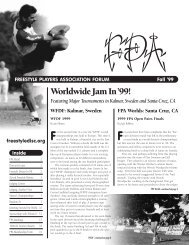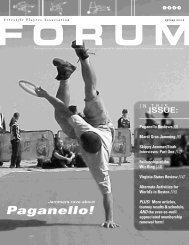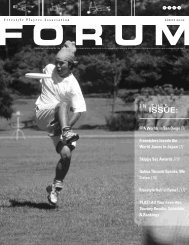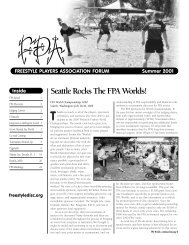Fires Up the FPA Worlds! - Freestyle Frisbee Players Association
Fires Up the FPA Worlds! - Freestyle Frisbee Players Association
Fires Up the FPA Worlds! - Freestyle Frisbee Players Association
Create successful ePaper yourself
Turn your PDF publications into a flip-book with our unique Google optimized e-Paper software.
<strong>FPA</strong> FORUM<br />
22<br />
“Synopsis” (cont.)<br />
this new disc art form. The 1973 IFT was especially<br />
significant. Dan “<strong>the</strong> Stork” Roddick, Bob “Flash”<br />
Eberle and John Kirkland made <strong>the</strong>ir first visit.<br />
Irv Kalb and his New Jersey ultimate contingency<br />
were <strong>the</strong>re. Jim Kenner and Ken Westerfield,<br />
widely considered <strong>the</strong> second freestyle team,<br />
were <strong>the</strong>re.<br />
OCTAD AND THE CANADIAN OPEN,<br />
THE FIRST FREESTYLE<br />
TOURNAMENTS<br />
After <strong>the</strong> 1973 IFT, Dan Roddick and Bob Eberle<br />
began a feverish period of work that established<br />
<strong>the</strong> roots of competitive freestyle. First, <strong>the</strong>y laid<br />
<strong>the</strong> groundwork for a flying disc event called<br />
Octad which was comprised of eight distinct skill<br />
events. Then <strong>the</strong>y published <strong>the</strong>ir first issue of<br />
<strong>the</strong> “Flying Disc World” newsletter in March of<br />
1974.<br />
Octad was held in<br />
May of 1974 and<br />
featured an event<br />
called “Eastern Trick<br />
Catch.” This skill test<br />
consisted of two<br />
players, competing<br />
against one ano<strong>the</strong>r,<br />
taking turns throwing<br />
<strong>the</strong> disc back and<br />
forth with points<br />
awarded for trick<br />
throws and catches.<br />
Unfortunately, <strong>the</strong><br />
adversarial aspect of<br />
<strong>the</strong> game left <strong>the</strong><br />
players dissatisfied<br />
and a post event<br />
discussion on <strong>the</strong><br />
game generated <strong>the</strong><br />
suggestion that <strong>the</strong><br />
two players should<br />
work toge<strong>the</strong>r ra<strong>the</strong>r<br />
than against each<br />
o<strong>the</strong>r.<br />
It was also suggested that <strong>the</strong> players should be<br />
judged in a manner similar to ice skating and<br />
gymnastics. Dan Roddick’s reply to this<br />
suggestion, “Oh I don’t know, that would be so<br />
subjective. I don’t think it would work too well,”<br />
is a criticism that still reverberates at modern<br />
freestyle events. Jim Palmeri hosted a big disc<br />
golf and double disc court tournament in August<br />
of 1974 that was <strong>the</strong> backdrop for <strong>the</strong> burgeoning<br />
freestyle movement. <strong>Players</strong> spent much of <strong>the</strong>ir<br />
free time working on new throws, catches and<br />
tipping. Victor Malafronte showcased behind <strong>the</strong><br />
back throws, Irv Kalb displayed accurate and<br />
powerful one finger throws. Doug Corea was<br />
developing aerial between <strong>the</strong> leg catches. John<br />
Kirkland was trapping high curving shots between<br />
his knees and feet. Multiple tipping became <strong>the</strong><br />
latest game of one-upmanship. A two hour rain<br />
delay on Sunday moved <strong>the</strong> fun indoors. It was<br />
<strong>the</strong>re that Kirkland unveiled <strong>the</strong> air bounce throw<br />
and by <strong>the</strong> end of <strong>the</strong> day, ten consecutive tips<br />
had been achieved. <strong>Freestyle</strong> was reaching critical<br />
mass. Two weeks later, virtually <strong>the</strong> same crowd<br />
appeared at <strong>the</strong> third annual Canadian Open<br />
<strong>Frisbee</strong> Championships. This event featured <strong>the</strong><br />
very first freestyle pairs competition, conceived<br />
by Jim Kenner and Ken Westerfield. <strong>Players</strong> were<br />
judged by <strong>the</strong>ir fellow competitors. Along with<br />
<strong>the</strong> IFT, Jim and Ken were influenced by <strong>the</strong> late<br />
Mike “Muk” Young. The pair had been doing<br />
shows for several years before <strong>the</strong> 1974 Canadian<br />
Open. They thought freestyle was a natural<br />
addition to <strong>the</strong> traditional guts, distance and<br />
accuracy events that comprised competitions of<br />
that era. The Canadian Open featured eight<br />
freestyle teams. Among <strong>the</strong> illustrious pairings<br />
were Doug Corea/Jim Palmeri, John Kirkland/Jose<br />
Montalvo, Irv Kalb/Dave Meyers, Dan Roddick<br />
/Bruce Koger, Tom Cleworth/John Connelly and<br />
finally, Jim and Ken. The competitive art form,<br />
which began it’s gestation at Berkeley six years<br />
earlier, was born at <strong>the</strong> Canadian Open on Sunday<br />
August 18, 1974 at approximately 3:00 PM<br />
Eastern Daylight Savings Time.<br />
•SH<br />
It was <strong>the</strong>re that<br />
Kirkland unveiled <strong>the</strong><br />
air bounce throw and<br />
by <strong>the</strong> end of <strong>the</strong> day,<br />
ten consecutive tips<br />
had been achieved.<br />
ARTISTIC IMPRESSION, A<br />
SPECTATOR VIEWPOINT<br />
by Sammie Brodeur (Toddy’s much better half)<br />
I’ve been to countless <strong>Frisbee</strong> events and<br />
watched, I don’t know how many, videos. I’ve<br />
never given <strong>the</strong> judging system any thought until<br />
now. At <strong>the</strong> <strong>FPA</strong> <strong>Worlds</strong> in Rimini I saw a routine<br />
that was so moving it actually brought tears to<br />
my eyes and many o<strong>the</strong>rs. I know <strong>the</strong>y had drops<br />
and maybe not <strong>the</strong> hardest of moves. I still<br />
thought that <strong>the</strong>y should have won <strong>the</strong> artistic<br />
impression part of <strong>the</strong> judging. I was thinking to<br />
myself, what is artistic impression? In my<br />
dictionary artistic means: made or done with<br />
taste and skill with an eye to beauty. Impression<br />
means: an effect produced on <strong>the</strong> feelings or<br />
senses.<br />
It seems that <strong>the</strong> skill part of artistic is taken care<br />
of in <strong>the</strong> difficulty portion of judging. As I look at<br />
<strong>the</strong> entire page given to describe artistic<br />
impression for freestyle it doesn’t seem to<br />
describe artistic impression at all. In a run down<br />
of <strong>the</strong> categories of artistic impression, teamwork,<br />
flow, form & music choreography, all seem like<br />
<strong>the</strong>y are a part of execution. Variety and diversity<br />
are basically <strong>the</strong> same thing and also have<br />
nothing to do with artistic impression.<br />
To me, as a spectator, I love when <strong>the</strong> players<br />
have some fun with <strong>the</strong>ir routine and incorporate<br />
props or act out a mini play during <strong>the</strong>ir routine.<br />
This is artistic impression. Artistic impression is<br />
for <strong>the</strong> spectators as well as a way for <strong>the</strong> players<br />
to have fun. I have one thought that maybe artistic<br />
impression shouldn’t be a category at all. Then<br />
I have ano<strong>the</strong>r that if artistic impression is<br />
removed than <strong>the</strong> players will just focus on <strong>the</strong><br />
mechanical part of freestyle and <strong>the</strong>n freestyle<br />
won’t be so well, free. The category of artistic<br />
impression should be just that. Artistic and<br />
impression leave all that o<strong>the</strong>r stuff to difficulty<br />
and execution.<br />
I just finished reading an interview of Neil Young<br />
this morning and <strong>the</strong> interviewer asked Neil about<br />
The song “cinnamon girl” having <strong>the</strong> one note<br />
solo that is one of <strong>the</strong> greatest solos of all time<br />
and Neil’s reply was “yeah, well <strong>the</strong>re are a lot<br />
of different ways to play one note”<br />
•SB<br />
Platinum thanks to: Rik Downs









